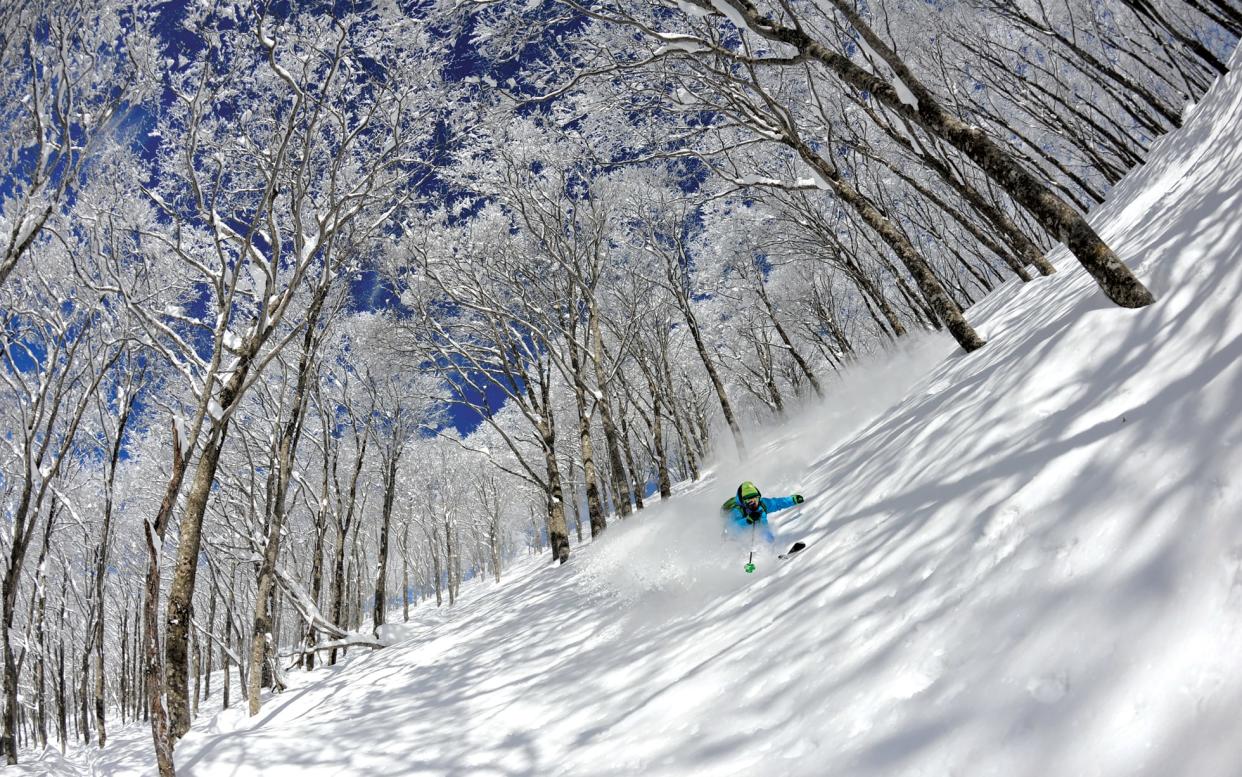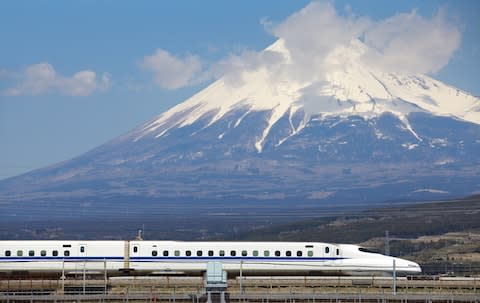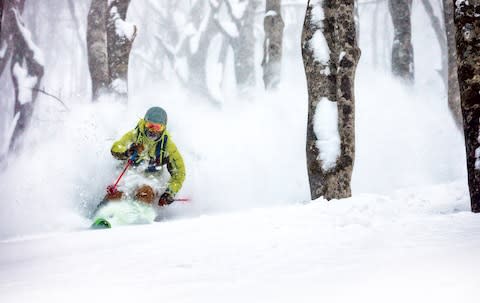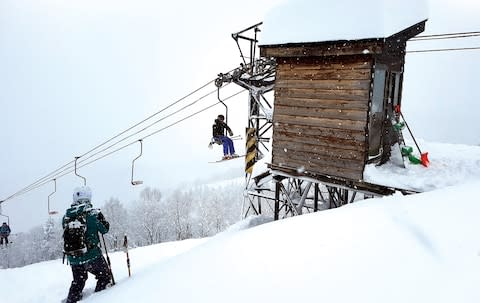Why skiing in Japan offers a lot more than just world-class powder

There are so many things I didn’t know before I skied in Japan. Among others, that a taxi driver in Toyko will willingly jam a pair of 180 powder skis into his boxy saloon car, that KitKats come in flavours from strawberry and green tea to wasabi, and that en-suite bathrooms are overrated – give me communal (though politely segregated) Onsen hot-pool ablutions any time.
However, one thing I did know: Japan’s reputation for deep, light powdery snow that falls regularly all winter, thanks to storms that willingly drop it on the mountains as they sweep in from the sea of Japan. And that, of course, is the main reason I wanted to go.
It’s the island of Hokkaido that most regularly features on ski and snowboard bucket lists – including mine. Its biggest resort of Niseko is famed for an annual 15m or more of snowfall each year. But it’s far from the only ski experience Japan has to offer, and by opting for two areas on Japan’s main island, Honshu, my friends and I not only skipped the extra flight from Tokyo to Sapporo that getting to Hokkaido entails, we could more easily add other wishes from our Japan list to the pick-n-mix of a two-week trip. City stopovers in both Tokyo and Kyoto, travel via shinkansen bullet trains with their beautiful swan-like heads, visits to ancient temples, the Jigokudani snow monkey park all being highlights.
The Hakuba and Myoko ski areas are in the Nagano and Niigata prefectures respectively, both within easy train reach of Tokyo via the 1998 Winter Olympic city of Nagano. Then Kyoto’s ancient centre made a bookend to nine days on the slopes, before we headed back to the capital.
First stop, Myoko, reached by bullet train from Tokyo to Nagano, then a connecting train to the small access town of Myoko Kogen – a dramatic slowing of pace after the raging 24-hour excitement of the bars, shops and thronging streets in the big city.

We are the only people on the Myoko train with ski bags; at 5.30pm most others look like they’re going home from work. The trip is only an hour, but as we chug along slowly, snow falls increasingly thickly, piling up at the side of the tracks and fuelling our excitement. But then, one stop before Myoko Kogen, at the tiny station of Kurame, the train stops.
Eventually we understand via sign language that the train is done for the night. And when we see a deep pile of powder on the track ahead, we know why.
The few remaining passengers gather in the station’s tiny waiting room, with uniformed officials talking fast and gesticulating. A local journalist turns up and asks us if we are annoyed about all the snow (No!). Then, finally, the news comes that free taxis are being organised for everyone, so we can complete our journeys.
We laugh with delight – imagine that happening at home! It’s all part of a beautifully polite and helpful culture that also means we are welcomed onto every ski lift, often with a bow as well as a greeting, and why that taxi driver in Tokyo was so accommodating with my skis.
Before I can be tempted by the unfamiliar snacks or a cat postcard advertised in a souvenir cabinet at Kurame station, our driver arrives. He piles skis on top of his van, then barrels us through the snow at hair-raising speed towards our final stop, Akakura Onsen, one of the Myoko area’s five ski hills.
Myoko, named for its highest mountain Myoko-san, 2,454m, claims 19m of snow annually. And it’s all over the streets as we arrive, covering cars, crunching underfoot, swirling from the dark sky, and making the brightly lit signs for restaurants, ski shops, and the tempting temple of a Japanese sweet shop look even more exotic in contrast.
Our eyes pop as the five of us wander the main street, trying to decide where to eat. We’re here for five nights, and there’s a lot of feasting to do, ramen noodle bowls, yakitori barbecue, sushi… the choice makes my mouth water every day. Though being faced with smoked fish and pickles along with eggs at the breakfast buffet of my hotel, the Akakura Annex, is rather unnerving at first.

There are novel drinks to try too – highballs, for example, as we wolf down our first noodle bowls. Whisky and soda with a fruit flavour of choice, in a pint, or a stein. But it’s cold sake in place of wine with dinner, and sweet yet sharp plum wine as a digestif, or aperitif, as well as locally brewed beer, that become our tipples of choice.
But we’re not going to get carried away on our first night, when there’s a first taste of Japanese powder to quaff next morning. We’re up early, jetlag notwithstanding, to hit the slopes of Akakura Onsen and linked Akakura Kanko as they open at 8.30am.
The area is not super challenging, though the couple of black runs are properly steep, but who cares, when our first forays sliding around distinctive birch trees with the still falling snow billowing around our faces are such fun. Being able to see through the trees makes route finding easier than through the more usual firs, and the endless repetition of white and black bark and flying snow is so mesmerising; I’ve rarely felt more in the moment.
When we stop for a noodle lunch, it takes time to get our heads round picking what to eat based on a picture, paying at a machine, getting a ticket then exchanging it for food. And we’re distracted by the posters stuck next to the queue line.

Signs on the slopes warn that going outside the area boundary is at your own risk, although hiking above the ropes is permitted with a guide. And the posters illustrate the terrible consequences of disobeying the rules. Dire warnings, yet the cartoon stories are so charmingly rendered we can’t help but laugh. How bad would it be, they speculate, to fall in a tree well while skiing alone, and only be found months later – and by a weeping friend, as the tree blooms with life overhead. But we did keep reading.
Days later, in Hakuba, off-piste rules are similar, and we’re warned our lift passes will be confiscated if we’re tempted to stray into forbidden areas. It’s a big place, 10 ski areas spread along a valley, linked by a lift pass and a shuttle bus. This runs between them into the night, so it’s easy to hit après bars or go out to sample restaurants in different base villages.
In general Hakuba is more on the radar among Japan ski watchers than Myoko, not least because it’s now a venue on the globe-trotting Freeride World Tour, the Hakuba leg scheduled for January 19-26 in 2019. But we are staying under the radar in Hakuba Norikura, linked to neighbouring Hakuba Cortina, furthest from the best known of the ski areas, Happo-One.
There may not be streets of fun bars and varied restaurants as in Happo, but Cortina has huge tree-skiing potential, with massively wide, long runs, and the rules for heading off piste are more relaxed. Designated ‘self-responsibility’ areas are open to experts, with the proviso that they bear the cost of any rescue.
We’re staying in the First Tracks Lodge. Run by the easygoing team of Catherine Chiam, her son James and Madoka Shiraki, it has a mixed Western/Japanese atmosphere and is a short stroll from the piste. We slide over the easy apron of slopes at the bottom of Norikura, then follow beautifully groomed pistes down to the huge, incongruous, red roofed, half-timbered Green Plaza hotel at the base of Cortina, before heading up to the top and into the trees.

The No 5 double chairlift heads up to a broad, forested valley and we watch it closely until it opens finally at 10.30am. Then session it repeatedly, choosing either the trees to the side of the scenic Itadaira One piste, or steeper runs next to the Grand Course run, charging the powder over and over again, before dragging ourselves away.
There are more runs off the back of Cortina, others higher up on Norikura, the compact piste maps belying the extent of possibilities – so much so we hardly feel the need to explore Hakuba’s other areas.
But we do have to go to Tsugaike, where every day the ski patrol runs a short safety briefing that entitles students to wear a double-black diamond armband and dive into extensive areas of trees that seem to take us miles from the long, wide pistes. Bigger than Cortina/Norikura, Tsugaike also has a gondola and a glorious 8km top to bottom piste that we just have to do nonstop.

Tsugaike is where we most often take the little night bus out to eat or drink, following recommendations. At Kushibe, after instruction from waiters, we construct okonomiyaki pancakes on the hotplate in the middle of our table, piling on cabbage, meat, pancake mix, shaping and scraping a circle, flipping and decorating it into submission. At Cloche we quiz barman Ken about his huge range of sake and plum wine, and his ceremonial sword, hanging on the wall above the bar.
We also venture to Happo-One and splash out on tempura and sushi around a sunken table in a private room at Washiya, then hit a clubby bar, just catching happy hour in the nick of time. Every night the bus rolls up in the snowy dark streets, right on time like magic, to take us home.
But it’s at Seki Onsen in Myoko that we have both the best on-mountain food of our stay, and the blown-away powder day that bucket-list dreams are made of. Following rumours that this tiny ski area with just two slow chairlifts, a double followed by a single seater, is the first benefactor of incoming storms, we taxi over there on our second day skiing in Japan.
A small queue of would-be freeriders builds in the fast falling snow, our fat skis and off-piste gear looking out of place at this family-run hill, its base just a hut for tickets and stickers, with a hairdryer outside for clearing goggles of snow. Yes, a hairdryer.
We spend the next hour or so lapping the double chair, finding numerous lines between trees, floating through deeps, occasionally seeing other riders or hearing muffled shouts as we spread out across one valley, traverse into a second. The lift provides drifting respite as it moves lazily through the trees while we’re on it, amid this relentlessly snowy day as we ski down.
Just as our knees are requesting a break, and home-made noodles and veg-stuffed miso soup in Taube are calling, there’s a commotion at the bottom of the single-seat lift. Piste patrol have finally dug it out, it’s opening – and we’re among the first on it.

It edges up over the pristine steep powder field below at a snail’s pace. As I near the top, the first skiers come down, barely visible in the deeps, their ecstasy evident from the pluming tails of snow, the bouncing turns and sounds of joy. I laugh with them, kicking my skis excitedly in barely contained anticipation of the over-my-head powder thrills to come. Lunch, good as it is, will have to wait.
Need to know
For more about ski resorts in Nagano and Niigata, including hotels, visit classic-resorts.jp. Visit seejapan.co.uk for further practical information and cultural highlights. Three-star Akakura Hotel Annex in Akakura Onsen, with four of varying size and heat, has rooms from ¥13,000 a night for two people B&B. First Tracks Lodge in Hakuba Norikura has rooms from ¥15,000 a night for two people B&B. The Japan Rail Pass for international visitors costs ¥29,110 for seven days. Also available for 14 or 21 days.


